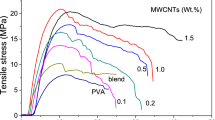Abstract
Poly(vinyl alcohol)/poly(vinyl pyrrolidone)/pumice composites were prepared with various loadings of pumice particles by a simple and environmental friendly solution blending. The influence of pumice particles in the blend was examined by different characterization techniques like FTIR, UV, XRD, SEM, DSC, TG and conductivity measurements. FTIR and UV spectra indicated the nature of pumice particle interaction with the blend matrix. XRD patterns revealed that amorphous nature of the blend decreases due to the interaction of pumice particles with the blend segments. SEM images showed the uniform dispersion of filler in the polymer matrix, and the dispersion of pumice decreased with increase in pumice content. Analysis of the DSC studies showed a significant decrease in glass transition temperature with an increase in mass percentage of pumice. Thermal decomposition temperature of the composite was gradually increased with the increase in concentration of pumice particles. The mechanical and electrical properties such as tensile strength, AC electrical conductivity, dielectric constant and dielectric loss of the composite were higher than pure blend, and these properties increased with the increase in dosage of pumice particles, whereas the elongation at break of the composite decreases with the addition of pumice particles.











Similar content being viewed by others
References
Yan X, Tsotsis TT, Sahimi M. Fabrication of high-surface area nanoporous SiOC materials using pre-ceramic polymer blends and a sacrificial templates. Microporous Mesoporous Mater. 2015;210:77–85.
Ali IO. Sol–gel synthesis of NiFe2O4 with PVA matrices and their catalytic activities for one-step hydroxylation of benzene into phenol. J Therm Anal Calorim. 2014;116:805–16.
Krumova M, Flores A, Calleja FB, Fakirov S. Elastic properties of oriented polymers, blends and reinforced composites using the microindentation technique. Colloid Polym Sci. 2002;280:591–8.
Soukal F, Ptacek P, Masilko J, Opravil T, Havlica J, Drdlova M. High temperature properties of MDF composite based on calcium aluminate cement and polyvinyl alcohol. J Therm Anal Calorim. 2014;115:1245–52.
Ramesan MT. Effect of silica on uncompatibilised and compatibilised styrene butadiene rubber and nitrile rubber blends. Int J Polym Mater. 2011;60:1130–46.
Iijima M, Kosaka S, Hatakeyama T, Hatakeyama H. Phase transition of poly(vinyl alcohol) hydrogel filled with micro-fibrillated cellulose. J Therm Anal Calorim. 2016;123:1809–15.
Mallakpour S, Dinari M, Hatami M. Novel nanocomposites of poly(vinyl alcohol) and Mg–Al layered double hydroxide intercalated with diacid N-tetrabromophthaloyl-aspartic. J Therm Anal Calorim. 2015;120:1293–302.
Sunitha K, Kumar YVLR, Sridhar S. Effect of PVP loading on pervaporation performance of poly(vinyl alcohol) membranes for THF/water mixtures. J Mater Sci. 2009;44:6280–5.
Kitis M, Kaplan SS, Karakaya E, Yigit NO, Civelekoglu G. Adsorption of natural organic matter from waters by iron coated pumice. Chemsophere. 2007;66:130–8.
Alemayehu E, Lennartz B. Adsorptive removal of nickel from water using volcanic rocks. Appl Geochem. 2010;25:1596–602.
Panuccio MR, Sorgona A, Rizzo M, Cacco G. Cadmium adsorption on vermiculite, zeolite and pumice: batch experimental studies. J Environ Manag. 2009;90:364–74.
Gok A, Gode F, Turkaslan BE. Synthesis and characterization of polyaniline/pumice (PAn/Pmc) composite. Mater Sci Eng B. 2006;133:20–5.
Khorzughy SH, Eslamkish T, Ardejani FD, Heydartaemeh MR. Cadmium removal from aqueous solutions by pumice and nano-pumice. Korean J Chem Eng. 2015;32:88–96.
Terra FS, Mahmou GM, Mourad L, Tawfik A. Structural and electrical properties of In–Se films deposited by thermal evaporation. Indian J Phys. 2012;86:1093–100.
Takei T, Nakada M, Yoshikawa N, Hiroe Y, Yoshida H. Effect of organic functional groups on the phase transition of organic liquids in silica mesopores. J Therm Anal Calorim. 2016;123:1787–94.
Akbal FO, Akdemir N, Onar AN. FT-IR spectroscopic detection of pesticide after sorption onto modified pumice. Talanta. 2000;53:131–5.
Ersoy B, Sariisik A, Dikmen S, Sariisik G. Characterization of acidic pumice and determination of its electrokinetic properties in water. Powder Technol. 2010;197:129–35.
Ramesan MT. Synthesis, characterization and properties of new conducting polyaniline/copper sulphide nanocomposites. Polym Eng Sci. 2014;54:438–45.
McDonnell MT, Keffer DJ. Intrinsic relationships between proton conductivity and nanopore size and functionalization. Microporous Mesoporous Mater. 2013;177:17–24.
Ramesan MT. Flammability, oil resistance and interaction of petroleum fuels with dichlorocarbene modified styrene butadiene rubber/fly ash composites. Pet Sci Technol. 2014;32:1775–83.
Nihmath A, Ramesan MT. Development, characterization and conductivity studies of chlorinated EPDM. AIP Conf Proc. 2014;1620:353–9.
Gangopadhyay R, De A. Conducting polymer nanocomposites: a brief overview. Chem Mater. 2000;12:608–22.
Ramesan MT. Synthesis and characterization of magnetoelectric nanomaterial composed of Fe3O4 and polyindole. Adv Polym Technol. 2013;32:928–34.
Athanasopoulos N, Baltopoulos A, Matzakou M, Vavouliotis A, Kostopoulos V. Electrical conductivity of polyurethane/MWCNT nanocomposite foam. Polym Compos. 2012;33:1302–12.
Ramesan MT. Dynamic mechanical properties, magnetic and electrical behavior of iron oxide/ethylene vinyl acetate nanocomposites. Polym Compos. 2014;35:1989–96.
Sareena C, Ramesan MT, Purushothaman E. Utilization of coconut shell powder as novel filler in natural rubber. J Reinf Plast Compos. 2012;31:533–47.
Ramesan MT. Effect of fly ash on thermal stability, flammability, oil resistance and transport properties of chlorinated styrene butadiene rubber composites. J Elastomers Plast. 2014;46:303–24.
Ke H, Pang Z, Xu Y, Chen X, Fu J, Cai Y, Huang F, Wei Q. Graphene oxide improved thermal and mechanical properties of electrospun methyl stearate/polyacrylonitrile form-stable phase change composite nanofibers. J Therm Anal Calorim. 2014;117:109–22.
Ramesan MT. Fabrication, characterization and properties of poly(ethylene-co-vinyl acetate)/magnetite nanocomposites. J Appl Polym Sci. 2014;131:3681–9.
Acknowledgements
The authors wish to thank Prof. P. P. Pradyumnan, Department of Physics, University of Calicut, and Prof. P. Pradeep, Department of Physics, NIT Calicut, for providing necessary facilities in the department.
Author information
Authors and Affiliations
Corresponding author
Rights and permissions
About this article
Cite this article
Ramesan, M.T., George, A., Jayakrishnan, P. et al. Role of pumice particles in the thermal, electrical and mechanical properties of poly(vinyl alcohol)/poly(vinyl pyrrolidone) composites. J Therm Anal Calorim 126, 511–519 (2016). https://doi.org/10.1007/s10973-016-5507-6
Received:
Accepted:
Published:
Issue Date:
DOI: https://doi.org/10.1007/s10973-016-5507-6




